DESCRIPTION of SPECIES
Kingdom: Animalia
Phylum: Chordata
Subphylum: Vertebrata
Class: Osteichthyses (the bony fishes)
Order: Tetraodoniformes (trigger fish, boxfish, porcupinefishes, pufferfishes)
Family: Molidae
Genus, Species: Mola mola, Mola tecta, Mola alexandrini, Masturus lanceolatus, Ranzania laevis.
Presently, five species are recognized within the family Molidae. Species include: the common mola, Mola mola (Linnaeus 1758); giant ocean sunfish, Mola alexandrini (Ranzani 1839); the hoodwinker sunfish, Mola tecta (Nyegaard et al. 2017); the sharptail sunfish, Masturus lanceolatus (Lienard 1840); and the slender sunfish, Ranzania laevis (Pennant 1776). Throughout the world, a number of intriguing common names exist for ocean sunfishes including:
Throughout the world, a number of intriguing common names exist for ocean sunfishes including:
- Poisson lune (France) (meaning “moon fish”)
- Schwimmender kopf (German) (meaning “swimming head”)
- Putol (Philippines) (Bisaya dialect for “cut short”)
- Manbo マンボウ (Japanese)
- Toppled car fish (Taiwanese)
- Bezador (Spanish)
- Makua (Hawaiian)
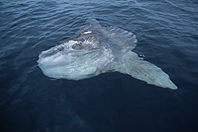
A NOTE ABOUT NAMES
The common name “sunfish” is used to describe the marine family, Molidae, as well as the freshwater family, Centrarchidae. The common names “ocean sunfish” and “mola” refer only to the family Molidae and can be applied all three Molidae species.
The word mola comes from Latin and means millstone–in reference to these fishes’ roundish shape. The common name “ocean sunfish” comes from their habit of lying atop the surface of the ocean appearing to sunbathe.
Click here for more common names.
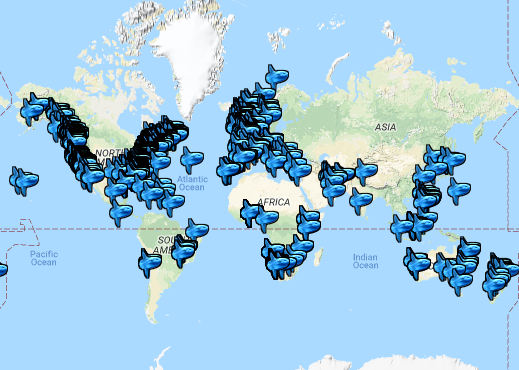
All species of sunfishes are found in tropical and temperate ocean basins. Recent tagging studies have finally laid to rest the historical characterization of sunfishes as passive drifters (Pope et al. 2010). These tagging studies have revealed that sunfishes have high-performance burst swimming abilities (e.g. Watanabe and Sato 2008, Nakamura and Sato 2014, Nakamura et al. 2015, ( 6m/s) Thys et al. 2015 ) and can swim long distances against major currents (e.g. Cartamil and Lowe 2004, Sims et al. 2009, Dewar et al. 2010, Sousa et al. 2016, Chang et al. 2019).
With information gleaned from satellite tagging studies, ultrasonic tagging and our internet sighting form, we are starting to piece together the seasonal distribution patterns of ocean sunfish populations throughout the world ocean. For example, Mola mola in the Western Pacific off Japan, have been recorded moving from Kamogawa, Japan northwards to the Kuril Islands off Russia (Dewar et al. 2010) during the summer months. In Indonesia, sunfish tagged in Bali were found to move eastward along frontal margins during the wet season (Thys et al. 2015). In the Eastern Pacific, individuals tagged in Central and Southern California migrate as far as southern Baja California during the fall and winter months (Thys et al. 2016). In the Western Atlantic, individuals tagged off Nantucket and Florida in the summer months moved into the Gulf of Mexico (Potter et al. 2011, Potter and Howell 2010) while in the Eastern Atlantic, sunfish tagged off the UK moved south to Spain to the Gulf of Cadiz (Sousa et al. 2016). Sunfish off South Africa move offshore but don’t exhibit substantial latitudinal migrations (Hays et al. 2009). Examination of these movement patterns from a global perspective leads us to conclude that sunfishes are facultative seasonal migrants (Phillips et al. 2017).
Sunfishes are also known to exploit different vertical segments of the water column. Tagging studies have revealed that sunfish make daytime excursions to the deep-sea, as far deep as 884 meters for Mola mola (Potter and Howell 2011) and 1,112 meters for Mola alexandrini (Thys et al. 2015), particularly in winter months. These vertical movement patterns are consistent with diel vertical migration patterns and are likely linked to prey abundance and distribution. Sunfishes are thought to consume abundant, shallow medusae in warmer months and rely on deeper, vertically migrating gelatinous prey during cooler months, explaining the seasonality of their deep-sea excursions.
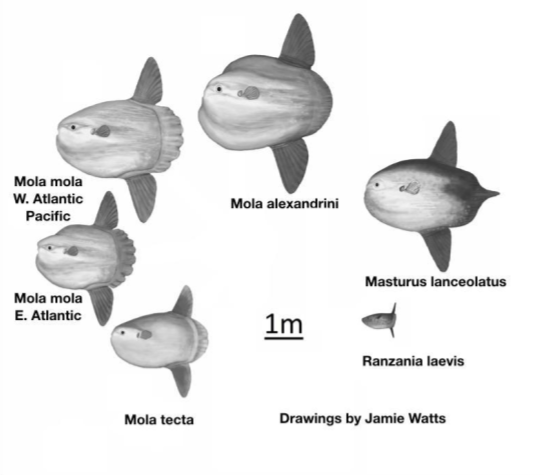
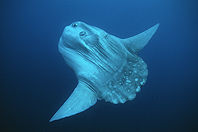
Mola mola (Common mola)
The most abundant and widespread of ocean sunfishes in the northern hemisphere is Mola mola. These fish, like all ocean sunfishes, have a peculiar body form (morphology). They are deep-body and truncated with a large head and a set of long dorsal and anal fins, reminiscent of a plane’s wings. These exaggerated, vertically oriented fins help sunfish produce the lift-based swimming ability that they need to effectively traverse large horizontal and vertical distances in the ocean.
Mola mola have a rounded tail when they are juveniles which can become scalloped as they mature and become larger. Some adults in the eastern Atlantic can possess a bulbous head similar to Mola alexandrini. The scales of M. mola are multi-cusped and jagged making their skin very gritty like rough sandpaper. M. mola are covered with copious amounts of mucus and typically silvery in color with a slight opalescent sheen and can also be dappled with spots. M. mola’s clavus (the sunfish version of a “tail”) is supported by 8-9 ossicles (small, bony formations) and 10-13 rays (Nyegaard et al. 2016). M. mola can grow to be enormous: nearly 11 feet long and 2910 lbs (Heilner 1920, Kawakami et al. 2008, respectively).
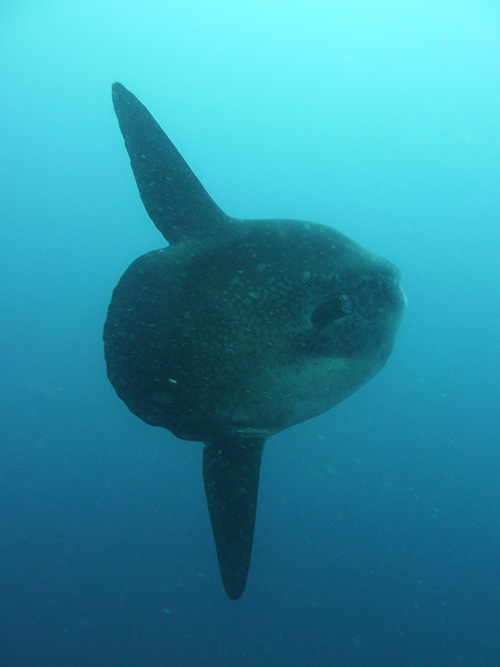
Mola alexandrini (giant ocean sunfish) photo credit: Kevn Weng
Mola alexandrini is similar to Mola mola, particularly in its juvenile stages, but diverges as itmatures by retaining a rounded clavus. M. mola, in contrast, can develop a wavy, scalloped clavus in its largest size. M. alexandrini’s rounded clavus is supported by 8-15 (average 12) ossicles and 14-24 (average 17) fin rays. Adults have an enlarged bulbous head, chin bump and rectangular scales. M. alexandrini can similarly grow to be huge: maximum size records are nearly 11 feet long and 5070 lbs (Yoshita et al. 2009, Sawai et al. 2018, respectively). M. alexandrini is found in both temperate and tropical waters. Scales of M. alexandrini are rounded when small (29-51 cm TL) becoming more rectangular at larger sizes (>120 cm)
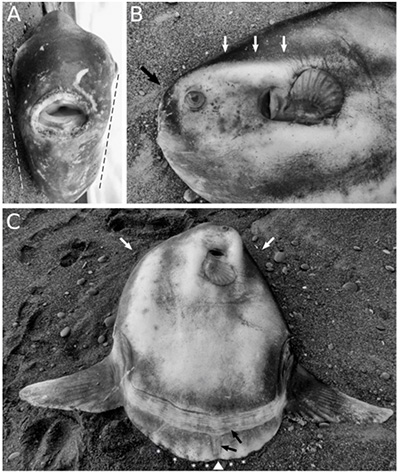
Mola tecta (hoodwinker sunfish)
image credit: https://academic.oup.com/
Mola tecta is the first new sunfish species described in over 130 years (see Nyegaard et al. 2018). They are known to reside in the southern hemisphere, with most records from South America, South Africa, Australasian waters and New Zealand. However, specimens of this species have been recorded along the California coast in 2019. M. tecta has a rounded clavus and a pronounced back-fold with 5-7 ossicles and 15-17 fin rays (Nyegaard et al. 2016). The scales of M. tecta are distinct from the other molids in that the raised conical mid-points of the scales are set far apart from each other..
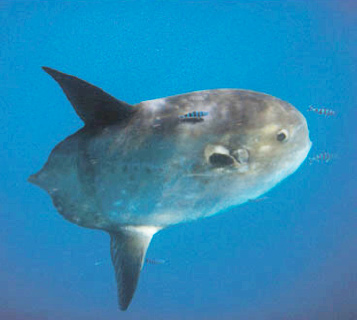
Masturus lanceolatus (Sharp-tailed mola) photo: Cindy Manning
As their common name implies, Masturus lanceolatus, have a bit more to their tail (e.g. a “median extension”) than Mola mola. Additionally, Ma. lanceolatus’ clavus is not scalloped. Similarly colored to Mola mola, Ma. lanceolatus has smoother skin and produces less mucus. Interestingly, Ma. lanceolatus are not consummate sunbathers and are more tropical in their distribution. While Ma. lanceolatus is currently the only accepted species in this cosmopolitan genus, there are more species waiting to be formally described. Ma. lanceolatus can grow quite large, as large as 10 feet long and 902 lbs (Gudger and MacDonald 1935, Gudger 1937; Liu et al. 2009, respectively).
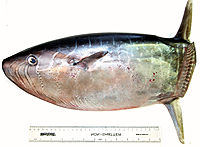
Ranzania laevis (Slender mola, dwarf mola)
Ranzania laevis is the smallest of mature adult sunfishes, reaching only approximately 74 cm in total length (Bloch and Schneider 1801). Additionally, R. laevis is less deep-bodied than other sunfishes, is oblong in shape, and has elongate pectoral fins. R. laevis is the most colorful of the ocean sunfishes, with smoother, thinner skin and funnel-shaped lips. With only one species currently recognized in the genus Ranzania, it is very likely that there are more species waiting to be formally described.
Distribution, Movements, and Ranges Cited Literature:
Cartamil, D.P. and C.G. Lowe. 2004. Diel movement patterns of ocean sunfish Mola mola off southern California. Marine Ecology Progress Series 266: 245–253.
Chang, C.T., Lin, S.J., Chiang, W.C., Musyl, M.K., Lam, C.H., Hsu, H.H., Chang, Y.C., Ho, Y.S. and Tseng, C.T., 2019. Horizontal and vertical movement patterns of sunfish off eastern Taiwan. Deep Sea Research Part II: Topical Studies in Oceanography, p.104683.
Dewar, H., T.M. Thys, S.L.H. Teo, C. Farwell, J. O’Sullivan, T. Tobayama et al. 2010. Satellite tracking the world’s largest jelly predator, the ocean sunfish, Mola mola, in the Western Pacific. Journal of Experimental Marine Biology and Ecology 393: 32–42.
Hays, G.C., M. Farquhar, P. Luschi, S. Teo and T. Thys. 2009. Vertical niche overlap by two ocean giants with similar diets: Ocean sunfish and leatherback turtles. Journal of Experimental Marine Biology and Ecology 370(1-2): 134–143. Available at: http://linkinghub.elsevier.com/retrieve/pii/S0022098108006096.
Nakamura, I. and K. Sato. 2014. Ontogenetic shift in foraging habit of ocean sunfish Mola mola from dietary and behavioral studies. Mar. Biol. 161(6): 1263–1273.
Nakamura, I., Y. Goto and K. Sato. 2015. Ocean sunfish rewarm at the surface after deep excursions to forage for siphonophores. J. Anim. Ecol. 84: 590–603.
Phillips, N.D., N. Reid, T. Thys, C. Harrod, N.L. Payne, C.A. Morgan et al. 2017. Applying species distribution modelling to a data poor, pelagic fish complex: the ocean sunfishes. Journal of Biogeography 44(10): 2176–2187.
Pope, E.C., G.C. Hays, T.M. Thys, T.K. Doyle, D.W. Sims, N. Queiroz et al. 2010. The biology and ecology of the ocean sunfish Mola mola: a review of current knowledge and future research perspectives. Rev. Fish Biol. Fish. 20(4): 471–487.
Potter, I.F., B. Galuardi and W.H. Howell. 2010. Horizontal movement of ocean sunfish, Mola mola, in the northwest Atlantic. Marine Biology 158(3): 531–540.
Potter, I.F. and W.H. Howell. 2011. Vertical movement and behavior of the ocean sunfish, Mola mola, in the northwest Atlantic. Journal of Experimental Marine Biology and Ecology 396(2): 138–146.
Sims, D.W., N. Queiroz, T.K. Doyle, J.D.R. Houghton and G.C. Hays. 2009. Satellite tracking of the world’s largest bony fish, the ocean sunfish (Mola mola) in the North East Atlantic. J. Exp. Mar. Biol. Ecol. 370(1-2): 127–133.
Sousa, L.L., N. Queiroz, G. Mucientes, N.E. Humphries and D.W. Sims. 2016. Environmental influence on the seasonal movements of satellite-tracked ocean sunfish Mola mola in the north-east Atlantic. Animal Biotelemetry. 4(7): 1–19.
Thys, T.M., J.P. Ryan, H. Dewar, C.R. Perle, K. Lyons, J. O’Sullivan et al. 2015. Ecology of the ocean sunfish, Mola mola, in the southern California Current System. J. Exp. Mar. Biol. Ecol. 471: 64–76.
Thys, T., J.P. Ryan, K.C. Weng, M. Erdmann and J. Tresnati. 2016. Tracking a marine ecotourism star: movements of the short ocean sunfish Mola ramsayi in Nusa Penida, Bali, Indonesia. Journal of Marine Biology 2016: 1–6.
Watanabe, Y. and K. Sato. 2008. Functional Dorsoventral Symmetry in Relation to Lift-Based Swimming in the Ocean Sunfish Mola mola. PLoS ONE 3(10): e3446.
